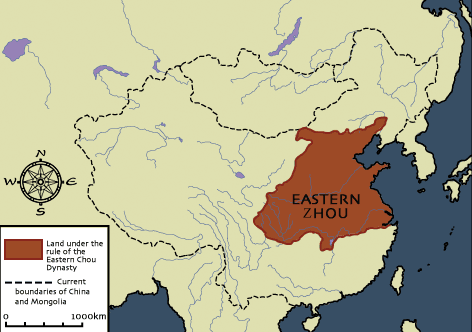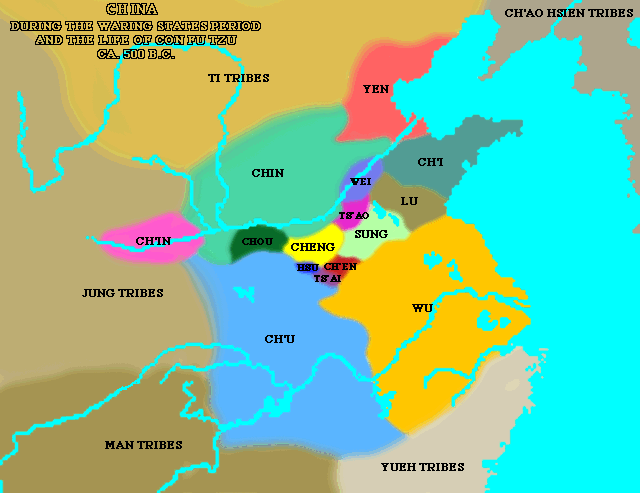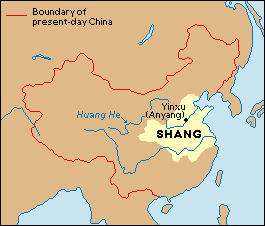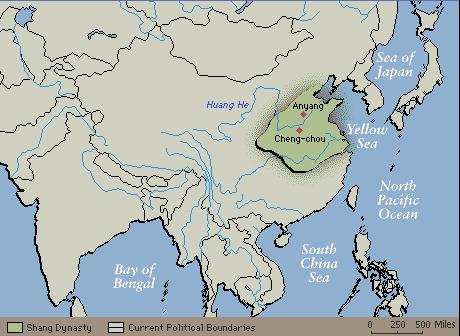As 201 Shang in the Bronze Age
Location: Yellow River Valley City of Anyang
Shang Dynasty Chronology
The Bronze Age Shang Dynasty in China is roughly dated between 1700-1050 BC, and, according to the Shi Ji, it began when the first Shang emperor, T'ang, overthrew the last of the Xia (also called Erlitou) dynasty emperors. They in turn were overthrown by the first rulers of the Zhou Dynasty, in 1046 BC.
In 1899, it was found that Chinese pharmacists were selling "dragon bones" marked with curious and archaic characters.These were finally traced back in 1928 to a site (now called Yinxu) near Anyang, north of the Yellow River in modern Henan province, where the Academia Sinica undertook archeological excavation until the Japanese invasion in 1937.
Archaeologists focused on the Yellow River valley in Henan as the most likely site of the states described in the traditional histories. After 1950, remnants of an earlier walled city were discovered near Zhengzhou.It has been determined that the earth walls at Zhengzhou, erected in the 15th century BC, would have been 20 metres (66 ft) wide at the base, rising to a height of 8 metres (26 ft), and formed a roughly rectangular wall 7 kilometres (4 mi) around the ancient city.
The rammed earth construction of these walls was an inherited tradition, since much older fortifications of this type have been found at Chinese Neolithic sites of the Longshan culture (c. 3000–2000 BC).[20] In 1959, the site of the Erlitou culture was found in Yanshi, south of the Yellow River near Luoyang. Radiocarbon dating suggests that the Erlitou culture flourished ca. 2100 BC to 1800 BC. They built large palaces, suggesting the existence of an organized state. (http://en.wikipedia.org/wiki/Shang_dynasty)
The Zhou Dynasty:
The dynasty that reigned for the longest period of time not only among all Chinese dynasties, but of the whole world. Such a long rule contributed to the image of the Zhou rulers and their political and ritual institutions as Role Models for all later dynasties.
--Western Zhou (Xian, 1045-771 BCE)

The founders of the Zhou dynasty were the Kings Wen 周文王 ( the Learned King) and Wu 周武王 (the Martial King); these two are often abbreviated to Wen-Wu 文武); and the Prince Regent, the Duke of Zhou 周公. They were seen as ideal monarchs. The Confucians venerated them as moral saints, as arbiters of humanity and righteousness. So when Confucius said "I follow Zhou" he was talking about looking back to these "Golden Years" of early Zhou and kingship and Rulership was as it should be.
--Eastern Zhou (Luoyang, 770-256 BCE)

In 770 BCE the Zhou had to move the capitol to the East, to Chengzhou 成周 (modern Luoyang 洛陽, Henan; so we call this second half of tehr Zhou Period the Eastern Zhou period,or Dongzhou 東周 (770-221 BCE) marked the beginning of a new era. Sometimes, this second halof of the Zhou is known as the "Spring and Autumn Period" Chunqiu 春秋 (770-5th cent. BCE), a time when members of the ruling elite developed new ideas on society and the universe. The philosophies of Confucianism (see Confucius 孔子) and Daoism emerged. At the same time, politicians tried implementing new forms of administration, in order to strengthen their states. Gradually, the states began to pull apart from the center, the Zhou capital, and to compete and war among themsleves. Eventually, one of the main 7 or 8 states was going to triumph over the others and establish a new Dynasty.
-------The Warring States Period (475-221 BCE)

The Warring States period Zhanguo 戰國 (5th cent.-221 BCE) is the later part of the so-called Eastern Zhou period Dongzhou 東周 (770-221 BCE). It is characterized by an increased centralisation and bureaucratisation within the feudal states of the Zhou empire. The kings of the Zhou dynasty 周 (11th cent.-221 BCE) had become politically - and also jurisdictionally - weak. The feudal lords, former vassals of the Zhou, were now acting independently of teh Zhou monarchs and were transforming thremselves into independant rulers that one after the other adopted the title of "King" (wang 王) that was formerly reserved to the Zhou dynasty. The state of Qin would eventually emerge as the most powerful state. it was governed by a line of strong rulers (Duke Xiao 秦孝公, King Zhaoxiang 秦昭襄王 and Ying Zheng 嬴政, the First Emperor of Qin 秦始皇帝) with able and ambitious political advisors as Shang Yang 商鞅, Lü Buwei 呂不韋 and Li Si 李斯, and excellent generals as Bai Qi 白起, Wang Jian 王翦 and Meng Tian 蒙恬. The installed their monarch as the ruler of all of China with a new title, Huangdi 皇帝," or "the August theoractic ruler" but we usually use the title Emperor for Chinese Monarchs from here on out.
Qin Dynasty - "The First Emperor" (221-210 BCE)
Qinshih Huangdi 秦始皇帝--the First Chin Emperor--mobilized huge armies abd conquered the other feudal states of the old Zhou kingdom 周. The state doctrine of the Qin kingdom was legalism, a philosophy focusing on the ruler and his skill to make use of a bureaucracy, supported by the quasi-objective effect of laws, standards and regulations. The whole territory of the Qin empire was divided into commanderies (jun) that replaced the ancient kingdoms and dukedoms of the Zhou era. Steps were taken to unify the diverse laws and standards that chacterized the looser, feudal arrangement and imposed a strong, central bureaucratic government. For example, the legal code of the state of Qin was used as the imperial code, with a few additions from the codes of the other ancient feudal states. The rigid application of this law code was the most important task of censors (jianchashi 監察使) that regularly visited the local offices. Also, Weights and Measures, the width of Road tracks, and the Script were all standardized. Households were registered to ensure a sufficient tax revenue and to have at hand lists of peasants that could be recruited for military service or to do, as corvée labourers, official work for dams and dykes, roads and official buildings, but also - most famously - for the tomb of the First Emperor at Xian, and the Great Wall in the north that was to protect imperial territory against the nomadic tribes of theSteppe like the Xiongnu 匈奴.
But, as you can see, The Qin Dynasty was not long lived. It only survived as long as its founder lived. It wound up being perceived by (Confucian) historians as the wrong way to govern all of China. Its laws were too harsh and its policies too inhumane; and when Confucianism became the ideal as far as standards of good government, it was because their approach was more moderate, more reasonable, more middle of the road. It purported to be ethical, more focused on Virtue (De 徳) and Goodness or Benevolence (仁 ren). It presented the argument that rulers were entitled to rule because they were better equipped to do so by being more virtuous, and this was confirmed by Tian (天) or Heaven which granted the monarch the right (Mandate) to rule by virtue of the fact that they won the day! If Heaven did not want them to rule, then somebody else would have won and they would lay claim to the Mandate of Heaven.
Han Dynasty (206 BCE-220 CE)
Instructions

